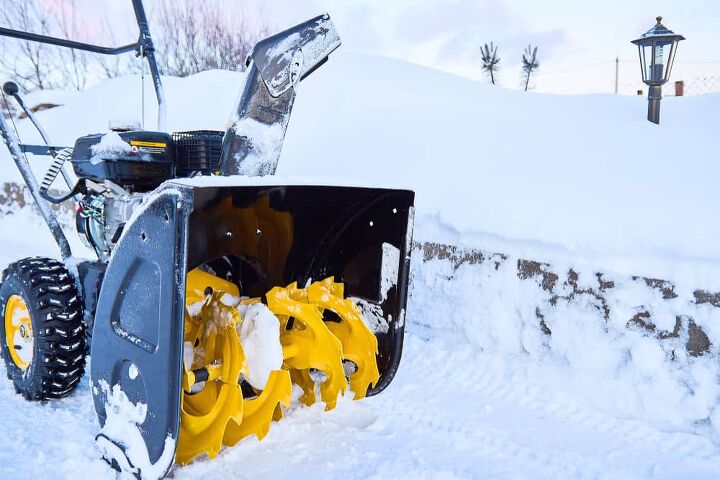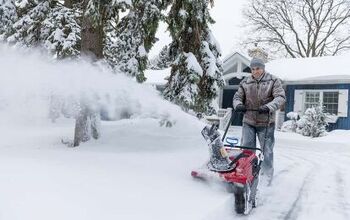Snow Blower Pull Cord Won't Recoil? (Possible Causes & Fixes)

Nothing is more aggravating than needing a piece of equipment, and it does not work when you need it. The ending of winter can be colder with more snow than in the beginning. The snowblower is necessary to clear the walkways, and you find after pulling the pull rope, it will not retract.
It is crazy how something minor can shut down an entire project. Repairing the recoil and rope is not as challenging as you may think it is. So, what do you do when you pull the rope, and it does not pull itself back into place?
You will need to remove the housing and replace the spring inside the starter recoil. The spring allows you to pull the rope for cranking, and it pulls itself back into place. This spring recoil will enable you to continue cranking until the snowblower starts up.
What is a Starter Recoil on a Snowblower?
Two to four-cycle gas-powered engines have a pull-rope to turn the engine. The best way to understand how the starter recoil works is by explaining how it looks inside. Each part has a purpose in cranking the snowblower, and the recoil is where it begins.
The starter recoil sits underneath the housing on top of the motor. It sits in groves, so it catches as it is turning the flywheel when the rope is pulled. As the mechanisms work together, the fat turning motion is what starts the engine.
Like every piece of machinery, something over time is bound to break. If the starter recoil locks up or the spring breaks, the rope will either lock up or not retract. Should this problem occur, it is impossible to start the engine.
Common Reasons the Starter Recoil Goes Bad
For all gas-powered snowblowers, there is a pull rope to turn over the motor when starting it. Several things can happen when the rope or the starter recoil goes bad. The engine’s main problem will not turn over if there is an issue with pulling the rope.
The rope may get caught up inside the recoil, and it is impossible to start the snowblower. Sometimes the rope may break inside the housing, and you may need a new one. Then there is the issue where you may pull the rope, and it will not retract.
For the retraction issue, the main culprit is the spring for the starter recoil has broken. Wear and tear is the number one problem, but rusting or dry rotting from sitting too long is another reason. You can relax in knowing it is an easy and quick fix through these steps to do it yourself.
How to Fix the Starter Recoil
- Remove the spark plug by unscrewing it with a 5/8” deep socket and ratchet. There will be no unexpected shocks while working metal to metal with the motor by removing the spark plug. Also, it allows you to remove the housing on top of the engine.
- Remove the recoil’s pull rope and open it up to get to the spring. The spring looks like a slinky and will probably be out of place.
- You will want to remove it from the outermost part first, then detach it from the middle grove. Once it is removed, you may discard it.
- There will be a grove to slip the new spring from the outermost part first. You will need gloves to keep from getting cut. The inner part of the spring goes inside the grove in the middle, where it will wrap around itself.
- Since the spring is like a slinky, it will be slightly tricky to wrap the first part around the spindle. As you are wrapping it around in the first loop, keep it deep in the grooves. The best way is to rotate it in your hands while holding it into place, an inch at a time.
- Do the same thing with the rest of the spring as you press down, putting each roll into place. After the first round, it goes much quicker, and you can apply more pressure with the gloves.
- It is now time to put the starter coil back together. Hook the outermost part to the connecting grove on the other half of the recoil as you put it together. Everything should fit into place without forcing it.
- You should always test the coil as you put everything back together by turning it counterclockwise. When you let it go, it should spring loose as the spring is released.
- Now that you know the recoil is working, turn it counterclockwise until it doesn’t turn anymore. You can put a screwdriver in the middle to keep it in place, so you can pass the rope through.
- To put the string back, you can fray the end and twist it to make it fit through the hole. Pull the rope enough to where you can knot the end. This will keep the rope in place.
- This step may be the most fun of them all, and it hardly takes any effort. The recoil does it all for you. Take the screwdriver out and let the spring do its thing as it retracts the rope in place.
- Now it is time to put everything back together. Put the recoil back on top of the starter and place the rope in its proper place. The handle should face the gas tank.
- Screw the housing back into place and put the spark plug back in.
- Once the spark plug is snug into place, you are ready to fire up the engine. Follow your routine when starting the snowblower and give it a few pulls. It should right up.
How to Lubricate the Starter Recoil
Before putting the recoil back together, there are a few tips that you can do to keep it working efficiently. Since the part is vital to starting the engine, it is good to spray lubrication.
Spraying lubrication will keep the metal parts from rubbing together, which will cause wear and tear over time. The chances are high if the metals are continuously rubbing; the spring can slip or break again soon after replacement. It is always best to take care of everything in maintenance while you have everything taken apart.
Another benefit added to lubricating the moving parts happens when you store the machine. The elements will be free of rust and corrosion.
How Much Does It Cost to Replace the Recoil Spring?
Replacing the recoil spring can be a DIY project, or you can bring the snowblower to a small engine shop. Doing it yourself will cost the parts of the spring and possibly the pull rope. The pull rope, on average, is $5, and the spring can cost between $5 to $25.
Bringing the snowblower to a mechanic shop, they will tack on another ten to 20 percent to the parts. They also charge by the hour, which is about a 30-minute job to change the spring and pull rope. They usually charge $65 to $75 per hour in labor.
When you total up the average prices, you come out way ahead, taking your time and doing the project yourself. Doing it yourself will cost an average total of $30. At a small engine repair shop, your average cost would be $75.
Inspecting the Starter Coil May Save You More Money
It is always essential to never panic when you have to take something apart. Sometimes when you take the starter recoil apart, you may find it is not broken. There are several times the spring may have slipped out of the groove.
When the spring is bent, it will throw everything off in the retraction mechanism. It is a simple fix, and all you will need is a pair of pliers. All you have to do is bend it back in place to fit the groove and slip it back in.
Related Questions
Is it true that the freezing temperatures can cause the spring not to work correctly?
Yes. If moisture gets into the housing chamber and it iced, it will affect the starter recoil spring. A quick fix is to thaw it out with a heating source such as a blow-dryer.
How long does the spring last inside the starter recoil?
It depends on where and how long it is stored. If the machine is stored in a place filled with moisture, the spring will rust and break in a short time frame.
Do I have to change the pull rope at the same time I change the spring?
Not necessarily. It is wise to inspect the rope, but there is no need to replace it if it shows no problems. However, if there are signs of needed replacement, it is best to do it while everything is open.

We are a team of passionate homeowners, home improvement pros, and DIY enthusiasts who enjoy sharing home improvement, housekeeping, decorating, and more with other homeowners! Whether you're looking for a step-by-step guide on fixing an appliance or the cost of installing a fence, we've here to help.
More by Upgraded Home Team












![10 Best Electric Pressure Washers – [2022 Reviews & Guide]](https://cdn-fastly.upgradedhome.com/media/2023/07/31/9070600/10-best-electric-pressure-washers-2022-reviews-guide.jpg?size=350x220)














